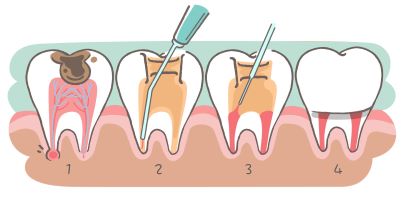Demystifying Root Canals: Separating Fact from Fiction

Root canals have long been surrounded by an air of fear and misconception. The mere mention of the term often conjures images of excruciating pain and discomfort. However, it’s essential to separate fact from fiction and dispel the myths surrounding root canals. In this blog post, we will explore what root canals are, why they are necessary, and what to expect during the procedure.
Understanding Root Canals
A root canal is a dental procedure performed to save a severely damaged or infected tooth. It involves removing the infected or injured pulp within the tooth, cleaning and disinfecting the root canal system, and sealing it to prevent further infection. The pulp, located in the center of the tooth, contains nerves, blood vessels, and connective tissue. When it becomes infected, it can lead to severe pain, abscesses, and potential tooth loss if left untreated.
Why Are Root Canals Necessary?
Root canals are necessary to save a tooth that would otherwise require extraction. Teeth can become damaged or infected due to deep decay, cracks, trauma, or repeated dental procedures on the same tooth. The pulp inside the tooth can become inflamed or infected, leading to intense pain and sensitivity. If the infection spreads, it can result in swelling, bone loss, and the formation of abscesses. By performing a root canal, a dentist can remove the infection, alleviate pain, and preserve the natural tooth structure.
Dispelling the Myths:
Myth: Root canals are extremely painful
Fact: Modern dentistry techniques and local anesthesia ensure that root canal procedures are generally no more uncomfortable than a routine dental filling. The pain commonly associated with root canals actually stems from the tooth infection itself, not the procedure.
Myth: Tooth extraction is a better alternative to a root canal.
Fact: Saving your natural tooth through a root canal is almost always the preferable option. Preserving your natural tooth maintains proper chewing ability, prevents adjacent teeth from shifting, and avoids the need for more extensive dental procedures like bridges or implants.
Myth: Root canals cause illness or systemic health problems.
Fact: The notion that root canals lead to systemic health issues has been thoroughly debunked. Root canals are a safe and effective procedure when performed by a skilled dentist using appropriate sterilization techniques.
The Root Canal Procedure:
- Examination and Diagnosis: The dentist will examine your tooth and take X-rays to assess the extent of the infection and determine if a root canal is necessary.
- Anesthesia: Local anesthesia is administered to numb the area around the affected tooth, ensuring a pain-free procedure.
- Access and Cleaning: The dentist creates an access point through the tooth’s crown to reach the infected pulp. The infected pulp is carefully removed, and the canals are thoroughly cleaned and disinfected.
- Filling and Sealing: Once the canals are clean, they are filled with a biocompatible material called gutta-percha. The access point is sealed with a temporary filling.
- Restoration: A dental crown or filling is placed over the treated tooth to restore its strength, function, and appearance.
Post-Procedure Care
After the root canal, it is normal to experience some sensitivity, which can be managed with over-the-counter pain medication. Maintaining good oral hygiene, including regular brushing and flossing, is crucial to prevent future dental problems. Regular dental check-ups will allow your dentist to monitor the treated tooth’s health.
Root canals are often misunderstood, but they are a vital dental procedure that can save your natural tooth and alleviate pain caused by infection or damage. By debunking the myths surrounding root canals and understanding the procedure’s purpose, we can overcome our fears and make informed decisions about our dental health. Remember, with advancements in dentistry, root canals are now more comfortable and effective than ever before, allowing you to maintain a healthy smile for years to come!